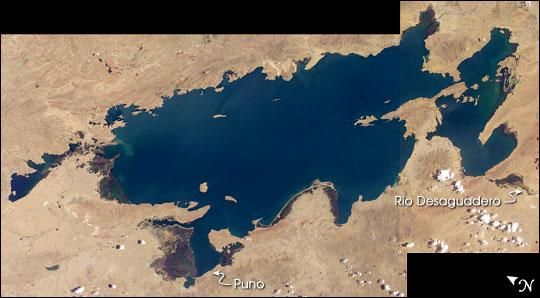
The World's Highest Large Lake

Lake Titicaca, at an elevation of 12,507 feet (3,812 meters) in the Andean Altiplano, is the highest large lake in the world. More than 120 miles long and 50 miles wide, it was the center of the Incan civilization, and today straddles the boundary between Peru and Bolivia.
Perhaps more importantly, Lake Titicaca contains one of South America's longest climate records, extending back more than 25,000 years, according to a NASA statement. Scientists have studied indicators of the water level changes over time in Lake Titicaca to tease out information about precipitation shifts in the high Andes and the South American tropics.
Because the lake occupies the low point of the Altiplano, much of the water of the high plateau eventually trickles into the lake. And because it is surrounded by mountains, very little of Lake Titicaca's water drains outthe Rio Desguadero is the only major outflow river. So, like a bathtub with no drain, this large and deep lake (with depths of several hundred feet) has become the collecting basin for more than 25,000 years of sediment. These sediments and their fossils contain clues about past climate conditions.
The restricted outflow of the lake creates conditions where even shorter, interannual climate cycles (like El Niño /Southern Oscillation) impact Lake Titicaca's water levels. Recent lake level variations have been several meters, with low levels occurring during regional droughts of El Niños.
Right now, the region is relatively wet. In this image, the dark greens of the wetlands along the shallower margins of the lake contrast strongly with the surrounding desert, while large cities like Puno, Peru (100,000 people), are difficult to discern from the surrounding countryside.
- Crater Lake: Deepest in the United States
- Cool La Nina Heats Up Fire Danger in U.S. Southwest
- Can Earth Survive?
Sign up for the Live Science daily newsletter now
Get the world’s most fascinating discoveries delivered straight to your inbox.












